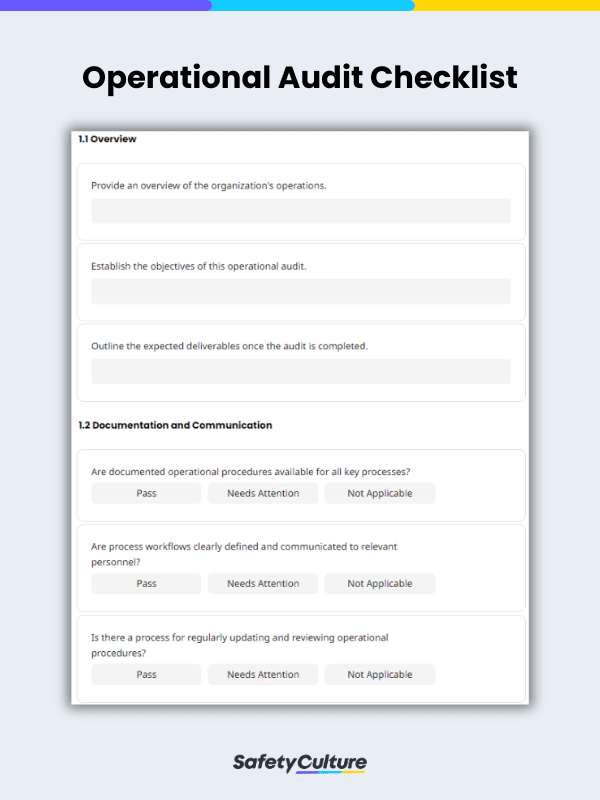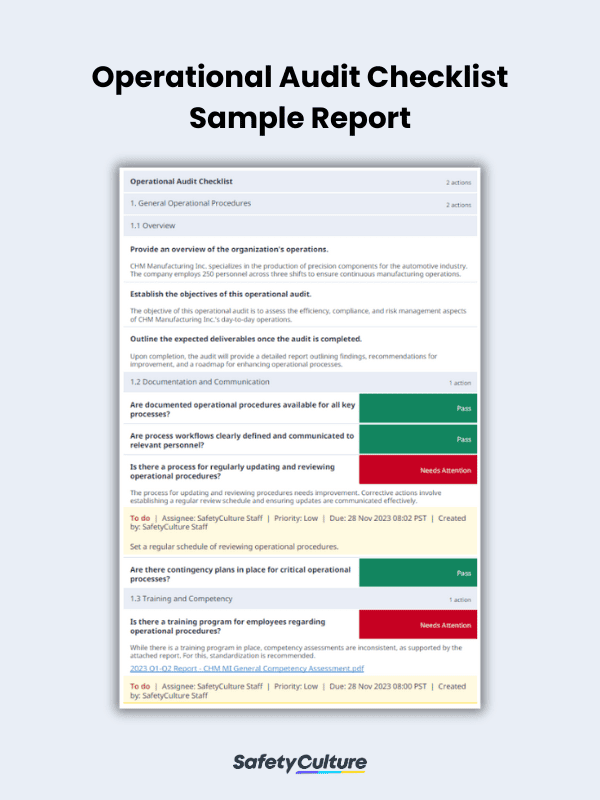What is an Operational Audit Checklist?
An operational audit checklist is a structured tool used to systematically evaluate various facets of an organization’s operational activities. It lists specific items, tasks, or criteria that auditors or evaluators follow to review processes, controls, and performance within the organization. With this checklist, organizations can identify areas for improvement, enhance efficiency, and comply with relevant standards, regulations, and best practices.
Why Use a Checklist for Operational Audits
Utilizing a checklist in the context of operational audits proves to be a strategic and effective approach, streamlining the evaluation process and ensuring a comprehensive assessment of an organization’s operational landscape. This is why it’s also important to create an audit plan to help establish the scope and objectives of such audits.
Apart from that, here are other reasons why incorporating a checklist is advantageous in the realm of operational audits:
Streamlined Evaluation Process
A checklist provides a structured framework for auditors, ensuring a systematic and thorough evaluation of various operational aspects. This structure allows auditors to follow a sequence, preventing oversight and enabling a more efficient identification of strengths and weaknesses in the organization’s operational procedures.
Enhanced Consistency and Standardization
Using checklists can also build a consistent process of auditing operations. It ensures that auditors assess the same aspects across different departments or periods, promoting fairness and reliability in the audit process. This standardization facilitates easier comparisons and trend analyses, leading to more informed decision-making by the management.
Compliance
Operational audit checklists also serve as a guide to verify that operational processes align with legal requirements and organizational standards. This not only helps mitigate regulatory risks but also provides a clear framework for implementing corrective actions and maintaining a culture of compliance within the organization.
In this sense, operational audit checklists can be used in high-risk and regulated industries, such as manufacturing, healthcare, and construction. For example, organizations in these sectors can follow Quality Management System (QMS) guidelines set by the International Organization for Standardization (ISO) and regulatory requirements mandated by the US Occupational Safety and Health Administration (OSHA).
What to Include in an Operational Audit Checklist
An operational audit checklist is a comprehensive tool designed to assess various dimensions of an organization’s operational processes. When creating such a checklist, consider including the following key components:
- Title Page — organization name, location, audit date, auditor name
- General Operational Procedures — overview, documentation and communication, training and competency
- Internal Controls — fraud prevention and asset safeguarding, financial controls
- Compliance and Legal Requirements — regulatory compliance, contractual agreements
- Risk Management — risk identification and assessment, reporting, and monitoring
- Technology and Information Security — IT systems and security, employee training
- Continuous Improvement — feedback mechanisms, implementation
- Completion Page — summary of findings, improvement recommendations or next steps, overall assessment, auditor sign-off
How to Create an Operational Audit Checklist
Crafting an effective operational audit checklist is a pivotal step in thoroughly examining an organization’s processes and controls. Follow these key considerations and steps to guide you in creating a comprehensive and tailored operational audit checklist:
- Identify and prioritize the key operational areas critical to the organization’s success. Consider input from stakeholders, management, and industry best practices when determining which processes to include to ensure diverse audits.
- Tailor the operational audit checklist to the unique characteristics and requirements of the organization. Make sure to incorporate feedback from key stakeholders to enhance the checklist’s relevance and effectiveness.
- Integrate mechanisms for continuous improvement into the checklist. Include sections for collecting feedback, monitoring Key Performance Indicators (KPIs), and implementing corrective actions.
- Regularly review and update the checklist to adapt to evolving organizational needs and changes in the operational environment.
How to Use an Operational Audit Checklist
Effectively utilizing an operational audit checklist helps organizations extract meaningful insights and improvements from the audit process. To use the checklist to its full potential, here are steps you can take:
- Engage relevant stakeholders, including department heads and operational staff, to gather insights and input. Encourage open communication to ensure that the audit process considers the perspectives of those directly involved in the operational areas under examination.
- Systematically document findings, observations, and evidence to support the assessment of operational processes.
- Analyze the collected data to identify patterns, trends, and areas of strength or weakness. Interpret results in the context of organizational goals, industry benchmarks, and regulatory requirements.
- Based on the audit findings, develop actionable and realistic improvement plans for identified weaknesses. Actively work with relevant stakeholders to implement corrective actions and enhancements and monitor the progress of these action plans.
Operational Audit Checklist Example
For small businesses, large enterprises, or anything in between, operational audit checklists serve as a straightforward tool to identify areas for improvement, strengthen controls, and foster a culture of ongoing enhancement within your operational landscape.
To give you an idea of what it looks like as a report, here’s a general example of a filled-out checklist after completing an operational audit:
FAQs About Operational Audit Checklists
While large organizations may have more complex and extensive operational processes, smaller organizations can also benefit from using checklists to evaluate and enhance their operational efficiency. The scope and depth of the checklist can be adjusted to match the scale and specific needs of each organization, ensuring that the audit process is relevant and impactful regardless of size.
For example, small and medium-sized enterprises (SMEs) can leverage operational audit checklists to identify areas for improvement, strengthen internal controls, and ensure compliance with regulations, contributing to their overall effectiveness and sustainability.
Yes, operational audit checklists are valuable tools for fostering continuous improvement within an organization. By systematically assessing various aspects of operational processes, these checklists help identify areas for enhancement, efficiency gains, and opportunities for innovation. The findings from operational audits, facilitated by the checklist, can inform the development of action plans and strategies aimed at continuous improvement.
A management audit checklist typically emphasizes high-level organizational components, assessing leadership effectiveness, strategic planning, and governance structures. It often includes items related to leadership competency, strategic decision-making, and the establishment of overarching policies and procedures.
In contrast, an operational audit checklist zooms in on the day-to-day functions of an organization. It delves into specific operational areas such as financial processes, internal controls, risk management, and compliance with regulations.
While both checklists contribute to organizational improvement, they differ in terms of their scope. The management checklist tends to have a strategic and holistic perspective, while the operational checklist provides a more granular assessment of the organization’s functional aspects.




